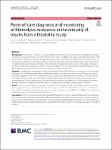Item Infomation
Full metadata record
| DC Field | Value | Language |
|---|---|---|
| dc.contributor.author | Lucy A., Coupland | - |
| dc.contributor.author | David J., Rabbolini | - |
| dc.contributor.author | Jonathan G., Schoenecker | - |
| dc.date.accessioned | 2023-03-23T02:03:07Z | - |
| dc.date.available | 2023-03-23T02:03:07Z | - |
| dc.date.issued | 2023 | - |
| dc.identifier.uri | https://link.springer.com/article/10.1186/s13054-023-04329-5 | - |
| dc.identifier.uri | https://dlib.phenikaa-uni.edu.vn/handle/PNK/7078 | - |
| dc.description | CC BY | vi |
| dc.description.abstract | ibrinolysisis is essential for vascular blood flow maintenance and is triggered by endothelial and platelet release of tissue plasminogen activator (t-PA). In certain critical conditions, e.g. sepsis, acute respiratory failure (ARF) and trauma, the fibrinolytic response is reduced and may lead to widespread thrombosis and multi-organ failure. The mechanisms underpinning fibrinolysis resistance include reduced t-PA expression and/or release, reduced t-PA and/or plasmin effect due to elevated inhibitor levels, increased consumption and/or clearance. This study in critically ill patients with fibrinolysis resistance aimed to evaluate the ability of t-PA and plasminogen supplementation to restore fibrinolysis with assessment using point-of-care ClotPro viscoelastic testing (VET). | vi |
| dc.language.iso | en | vi |
| dc.publisher | Springer | vi |
| dc.subject | tissue plasminogen activator | vi |
| dc.subject | acute respiratory failure | vi |
| dc.title | Point-of-care diagnosis and monitoring of fibrinolysis resistance in the critically ill: results from a feasibility study | vi |
| dc.type | Book | vi |
| Appears in Collections | ||
| OER- Y học- Điều dưỡng | ||
Files in This Item:

